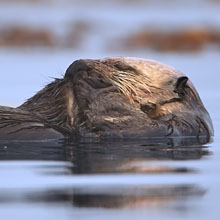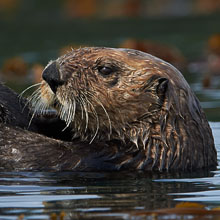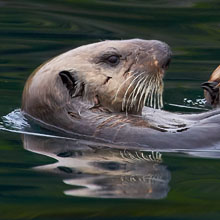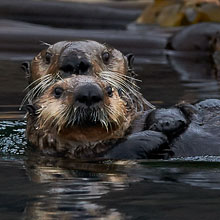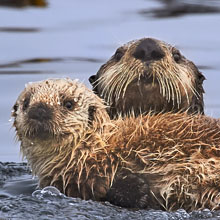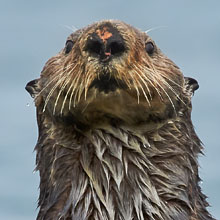Availability: Undetermined - Enquiries?
In the Field
Don't Mind Us - We're Just Bits of Kelp! Northern Vancouver Island Region, BC, Canada. August 14, 2014.
One of the most fascinating aspects of sea otter behavior is how the females interact with their kits. Sea otters are fully aquatic mammals that rarely go on land. Their kits are born without the ability to swim and initially rest on their mother's chest while she swims or floats on her back. Kits are usually weaned at about 6 months of age, and can swim very well long before that. This shot captures a kit that is approaching the age of weaning, but still seems to like hitch-hiking along atop mom's chest! We caught this mother-kit pair as they were motoring through a kelp forest, and we trolled beside them in our small Zodiac. When I look at this shot I'm left wondering who was the more curious of the other - the photographers or the subjects? ;-)
I find sea otters so cute and photogenic that I often try to move in tight for close-up shots (for portraits that emphasize their high "cute factor"). But what struck me about this "scene" - besides the dark and deep rich tones - was just how well the colour of the otters matched the colour of their surroundings. Given that this is the absolute definition of sea otter habitat, I guess that's no surprise. So rather than trying to move in for a tighter shot (and my 600mm lens was mounted on a camera right beside me), I intentionally chose to shoot a "looser" shot and capture the animals plus the environment in which they were found (a good ol' "enviroscape"). Good ol' adaptive colouration in action!
Here's a higher resolution (2400 pixel) version of the Ma and Kit for your viewing pleasure:
• Don't Mind Us - We're Just Bits of Kelp! Download 2400 pixel image (JPEG: 1.7 MB)
ADDITIONAL NOTES:
1. This image - in all resolutions - is protected by copyright. I'm fine with personal uses of it (including use as desktop backgrounds or screensavers on your own computer), but unauthorized commercial use of the image is prohibited by law. Thanks in advance for respecting my copyright!
2. Like all wildlife photographs on this website, this image was captured following the strict ethical guidelines described in The Wildlife FIRST! Principles of Photographer Conduct. I encourage all wildlife photographers to always put the welfare of their subjects above the value of their photographs.
3. This image was captured during my "Humpback, Orcas, Sea Lions & More" photo tour in August of 2014. Each year I offer trips into two different parts of the Great Bear Rainforest as well as one to photograph aquatic mammals and oceanscapes near the northern tip of Vancouver Island. And, in selected years, I also offer photo tours to locations to capture other highly sought-after subjects, such as various owl species of the boreal forest and wildlife of Canada's Arctic. Details about these trips can be found on the Photo Tours page of this website.
Behind the Camera
Don't Mind Us - We're Just Bits of Kelp! Northern Vancouver Island Region, BC, Canada. August 14, 2014.
Digital Capture; Compressed RAW (NEF) 14-bit format; ISO 2200.
Nikon D4s paired paired with Nikkor AF-S 400mm f2.8G VR - hand-held from Zodiac. VR on in Normal mode.
1/2000s @ f7.1; -0.67 stop compensation from "recommended" matrix-metered exposure setting.
At the Computer
Don't Mind Us - We're Just Bits of Kelp! Northern Vancouver Island Region, BC, Canada. August 14, 2014.
RAW Conversion to 16-bit TIFF, including first-pass/capture sharpening using Phase One's Capture One Pro. Three raw variants (different versions of a single raw capture) processed, differing by a total of 1.0 stops in exposure.
Further digital corrections on resulting 16-bit TIFF files using Adobe's Photoshop CC and Light Crafts Lightzone. Photoshop adjustments included compositing (blending) of the three output files from the raw converter, additional minor exposure and contrast tweaks, and selective sharpening for web output. Final tweaking of tones performed using LightZone's "tonemapper" and zonemapper tools.
Conservation
Don't Mind Us - We're Just Bits of Kelp! Northern Vancouver Island Region, BC, Canada. August 14, 2014.
Ten percent of the revenue generated by this image will be donated to Raincoast*.
Species Status in Canada**: Special Concern (April 2007) - protected off the North American coast since 1911.
Back in the late 1800's and early 1900's the Sea Otter (Enhydra lutris) was hunted to near extinction along both the Asian and North American Pacific Coasts. The reason? It's luxuriant coat. Otters are unlike any other aquatic mammal in that they don't use fat or blubber to insulate themselves from the chilling effects of the water they are found in. Instead, they rely on their amazingly thick fur coat for insulation. Their amazing coats have a higher density of hair (up to 150,000 strands of hair per square cm!) than any other animal in existence today. To ensure that this coat serves its insulative purpose, otters spend a disproportionately large amount of time grooming their coat (to ensure its natural oils continue to provide an effective waterproof barrier). Unfortunately, the biological functioning of the otters coat can be easily fouled by contamination by oil and other hydrocarbons - thus making them extremely sensitive to the effective of marine oil spills.
Other fascinating aspects of the biology and behaviour of the sea otter include the use of tools (they will use rocks to break apart shellfish such as sea urchins), and the fact that they have an metabolic rate two to three times higher than other mammals of their size. This means they must eat 23% to 33% of their own body weight DAILY, just to to replace the calories burned through maintaining their body temperature in the cold water environment they live in.
*The Raincoast Conservation Society (and Foundation) is an effective and efficient organization that has been fighting for protection of this unique habitat. If you are looking for a meaningful way to contribute to the conservation of this amazing ecosystem, Raincoast will provide maximal "bang" for your conservation dollars.
**as determined by COSEWIC: The Committee on the Status of Endangered Wildlife in Canada



















